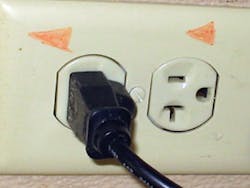As usual, never consider the following commentary associated with these photos as a formal interpretation of the National Electrical Code (NEC). Without criticizing anyone or any product, the following scenarios present us with serious safety questions.
All references are based on the 2005 NEC.
PAINT-ON PROTECTION
Tony Rampacek, manager — technical support, training and knowledge management, PARTech, Inc., Boulder, Colo., submitted this picture taken by one of his field representatives.
The company he works for installs and provides phone and field service for point-of-sale (POS) equipment in fast food restaurants. Its requirements state that the POS system must be connected to an isolated ground circuit to minimize the amount of noise the equipment may see. Such receptacles are orange in color most of the time, but the true identification is the delta symbol on the device.
“One of the common questions that comes up during our phone troubleshooting sessions is whether or not the equipment is plugged in to a receptacle with a triangle (delta) symbol on it,” Rampacek wrote. “After one such phone conversation, our local field rep found this interesting marking technique when visiting the customer's site. Seems as if a little creative art was performed on this receptacle.”
The Code covers isolated grounding type receptacles in 406.2(D). They're permitted for use only with grounding conductors that are isolated in accordance with 250.146 (D). The issue is also covered in 250.96(B). And see 250.119 for permitted methods of identification for equipment grounding conductors.
FUSES FOR ANY OCCASION
Timothy Mick, senior electrical designer, Alliance Engineering in Richmond, Va., found this installation in a facility in Virginia.
Electrical connections and terminals of conductors to terminal parts are covered in 110.14(A). It states that the connector must always ensure a thorough connection that won't cause damage to the conductors. The use of pressure connectors (including set-screw type), solder lugs, or splices to flexible leads is required by the Code. Also, any terminals for more than one conductor, and terminals used to connect aluminum are required to be so identified. It looks like these load side conductors have a few illegal taps, which make the possibility of a failure very real.
In addition, a new requirement in the 2005 NEC covers cartridge fuses of the renewable type [240.60(D)]. Class H cartridge fuses of the renewable type are only permitted for replacement in existing installations where there's no evidence of overfusing or tampering. Actual field experiences by this writer and some recent conversations with members in the electrical industry have reminded me of conditions where there were as many as three links in a 200A renewable type fuse. Although this photo shows only one, the other two will probably be replaced with Class H type fuses.
Found a Code violation? E-mail your photos to Joe Tedesco at [email protected].
About the Author
Joe Tedesco
Tedesco served the industry in many roles during his career. He was a director, senior electrical code instructor for National Technology Transfer, Inc. and American Trainco, Inc.. He was also a codes, standards and seminar specialist for the International Association of Electrical Inspectors and an electrical field service specialist for the National Fire Protection Association in Quincy, Mass. He ran his own business as an NEC consultant and is a Massachusetts licensed master electrician and journeyman electrician and certified electrical inspector (one and two family 2A; General 2B, and Plan Review, 2C). Tedesco also wrote articles for CEE News and EC&M (Code Violations Illustrated and What's Wrong Here?) for more than 15 years and helped launched the Moving Violations video series.
